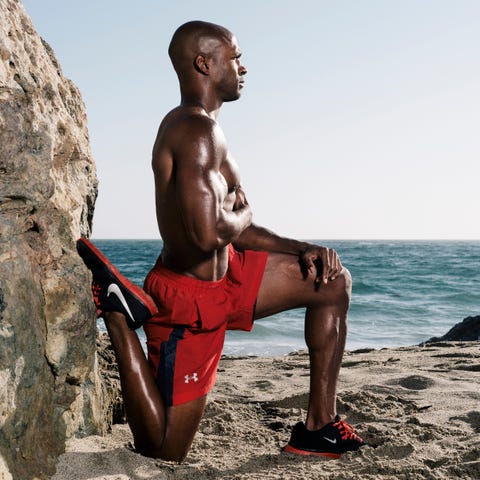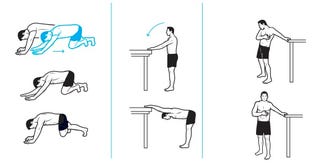Why You Should Devote 10 Minutes a Day to Mobility Training
Try this right now: Get off your couch and sink into a full squat with your feet flat on the floor. Now stay there for 10 minutes.
To physical therapist Kelly Starrett, you’re not truly fit until you can do that. This simple challenge, issued eight years ago on YouTube by Starrett, owner of a San Francisco CrossFit box, addresses a fitness weakness that most men ignore, and it exemplifies his philosophy.
Starrett preaches that working out should produce more than chiseled abs and bulging biceps. He wants the gym to restore mobility—that is, the raw range of motion that modern life, computer work, and commuting rob from us daily. Classic exercises alone can’t fix this, which is why Starrett talks about foam rollers, recovery balls, and VooDoo floss bands as often as he mentions kettlebells and dumbbells. It’s also why he posted that squat challenge. “I was like, how come no one has a basic understanding of how their body works?” he recalls. “So I decided to make a video every day for a year. I wanted people to focus 10 minutes a day on mobility.”
It’s a radical premise: According to Starrett, the point of going to the gym is not just to become thinner or stronger but also to restore normal, baseline physiological function. “That means being able to put your arms over your head without having to warm up,” he says. Plus, when you achieve greater mobility, it gives you a foundation on which to build greater strength and superior athleticism while insulating yourself from injury.
“Practice doesn’t make perfect. Practice makes permanent.”
Now Starrett works with sports teams and elite military units. He also founded StandUp Kids to combat childhood obesity. And on his MobilityWOD website, he issues challenges and tips—including how to crush the squat test—with the aim of helping guys set and achieve goals for improving the way they move. Essentially he’s quantifying mobility. “I create education tools and drills for busy people,” he says. “These tools let you refine your movement, making you feel better in the gym and in everything you do.”
That feeling eluded Starrett in his younger days, when he was a world-class paddler on the U.S. Canoe Team. Back then he was like everyone else, so uninterested in mobility that he made fun of a friend who stretched before practices and events. “Who cares about position when you’re young?” he says.“I’d never stretched before and had tons of back and shoulder pain paddling.”
All that pain led to a nerve-root issue in Starrett’s neck that doctors struggled to solve. And that led Starrett to chase his own answers—and uncover the benefits of simple mobility. “If you give guys postural exercises, they can clean up their movement issues so many common injuries never happen,” he says. That’s more important than ever in today’s work world, one that often forces your body into uncomfortable positions that compromise good, clean movement.
Four Modern Movement Maladies—And How to Solve Them

Jose Mandojana
The “problems” of today rarely require complicated fixes. All you have to do, says Starrett, is reinforce good body position habits.“Practice doesn’t make perfect,” he says. “Practice makes permanent.”
Do You Hunch Like a Gorilla?
Consider all the time you spend seated. Those long hours, either at home or at work, “monkey things up,” Starrett says, trapping your body in a hunched-over posture. Your shoulders roll forward and your back muscles weaken as your hip flexors tighten and your glutes and hamstrings loosen.
The Fix: Just spend a few minutes a day doing two moves—the couch stretch and the deep squat (see the images above). “These are things you can just noodle on,” Starrett says. “Just mess around with these positions a bit, and you’ll get comfortable in those ranges of motion.”
Do You Stand Like Donald Duck?
Snap a selfie of yourself standing sideways in a mirror. Don’t try to stand up straighter than natural and comfortable. Examine the photo. If you’re like most guys, your shoulders will roll forward, your back will be hunched, and your feet will be splayed out like a duck’s. This is no way to go through life, Donald.
The Fix: Stand with your feet pointing straight ahead. Starrett says “screwing” your feet into the ground and squeezing your butt for two seconds can help you do that while also aligning your hips with your spine. “Your back should be flat, belly tight, and head neutral,” he says. Every so often, put your hands on your chest for a moment, a reset that will help your shoulders feel comfortable and stable. Remember, practice makes permanent. So try to do this every time you stand up, which should be at least one to five minutes for every hour you’re seated.
Do You Drive Like Miss Daisy?
The same issues that plague you at a desk can arise when you’re behind the wheel of your car, except there’s no getting up and doing Starrett’s drills on I-95.
The Fix: Do the best you can to sit with a “well organized” upper back. One way to do this: When you get into your car, flip your palms upward and away from your body, as if you’re about to give somebody a hug. “What you’re doing is winding up the shoulder capsule, organizing the rotator cuff,” says Starrett. Now your shoulders are in a more organized position, and your chest will feel more open. Try to maintain that while driving. Also, raise your seat as high as you can without hitting the car roof. This makes it easier to keep your spine straight.
Is Your Warmup Soft?
Conventional wisdom endorses foam-rolling to loosen up before a workout, but Starrett contends that’s not a proper warmup. It relaxes your muscles, which he says isn’t what you want before you train.
The Fix: Save the soft-tissue work for after your workout or, even better, 10 minutes before you go to bed. It’s easier to get into the habit of doing it then, says Starrett, and relaxing your muscles might actually help you fall asleep. To properly warm up for your next workout, do low-intensity moves that mimic your workout, jump around, and shake out your limbs. Doing that will get blood flowing to your extremities.
Three for the Home Stretch

Source: Read Full Article


